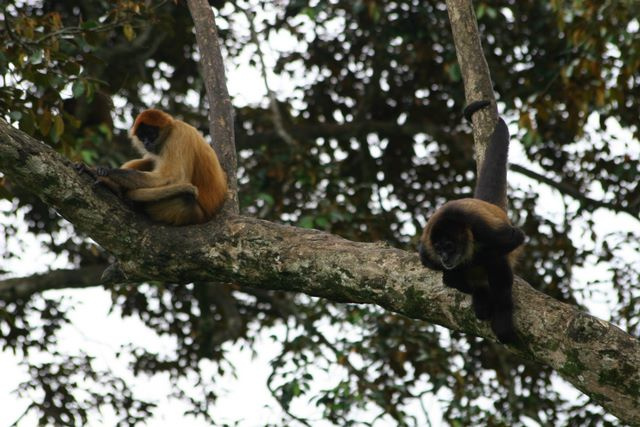Spider Monkey
Spider Monkey (Ateles geoffroyi) Spanish names: Mono Arana, Mono Colorado

More about Spider Monkey
Habitat
Spider monkeys tend to stay high off the ground in the canopy of tropical forests.
Range
The genus of spider monkeys ranges from Southern Tamaulipas in Mexico to Mato Grosso in Brazil. This species formerly was abundant in many parts of Central America. Now, due to hunting and deforestation, it is restricted to areas with patches of forest large enough to sustain its troop size. How intensively it was and is hunted depends on the area of Central America; but because it is one of the largest New World primate species, it is more vulnerable to hunting.
Physical Description
This species contains 9 subspecies based on color variation; the color of the back, shoulders, and tail varies from blonde to black depending on subspecies.
Biology and Natural History
They speed through trees using their forelimbs and tail in a brachiating fashion. Their limbs are long and slender, and they have fully prehensile tails-the most prehensile of all Central American primates-that can support their full weight.
Their group dynamics are complicated and change in the course of a day. They tend to subdivide into small groups, most frequently of 2 to 3 individuals, but also into minitroop formations with an adult male, a few adult females and their young. At the end of the day these subgroups reconvene into a single unit at sleeping trees, at which point there are several adult males, juvenile males, adult females and offspring. Their total group size is usually about 20 individuals. Aside from gathering into this big group at certain feeding and sleeping trees, spider monkeys look for food independently or in their small groups.
A single troop requires a territory of 2.5 to 4 km2, so within their ranges they have a low population density compared to capuchins or howlers. Because spiders depend so heavily on fruit, which is harder to find than leaves, they need larger territories than their relatives.
Protecting these territories is only one function of their complicated communication system. They communicate using vocalizations, facial expressions, and posturing. Additionally, adult males secrete chemicals from their chest glands which they use to mark territories. Spiders have different calls associated with different situations: for example, barking rallies a mobbing conglomeration against terrestrial predators or territory invaders, and at least 2 types of long calls are used to coordinate troop movements. They use loud calls to bring the group together and to declare territory claim to other groups.
An infant spider monkeys stays close to its mother for 3 months, at first carried on the stomach then riding on her side as it ages. Babies remain at least partially dependent upon their mother's milk for the first year of life. Gestation lasts 225 days every 2 to 3 years; it is partly because of this slow reproductive time that spider monkeys are very sensitive to human disturbance, and their populations do not recover quickly when reduced by hunting or deforestation.
Diet
These monkeys are almost exclusively frugivores, but sometimes they will supplement their fruit diet with young leaves for additional plant-protein.
Height/Weight
Adults of both sexes can be more than 8 kg and 1.28 m long from head to tail-but the tail is longer than the body and head. Males may be slightly heavier and have a longer head and body length, but female tail length can exceed that of the male. Infants are 500 g at birth.
Taxonomy
Order: Primates
Family: Cebidae
Sources
Eisenberg, John. Mammals of the Neotropics, Vol. 1. The University of Chicago Press: Chicago, 1989.
Eisenberg, J. F. in Janzen, Daniel H. Costa Rican Natural History. Chicago: University of Chicago Press, 1983.
Wilson, D. E. in Janzen, Daniel H. Costa Rican Natural History. Chicago: University of Chicago Press, 1983.
-Amy Strieter, Wildlife Writer
Spider Monkey Sightings
Similar Profiles
It's more than just having a good time or visiting beautiful places (although that's absolutely a part of it!), it's about being part of a unique experience that stays with you.



